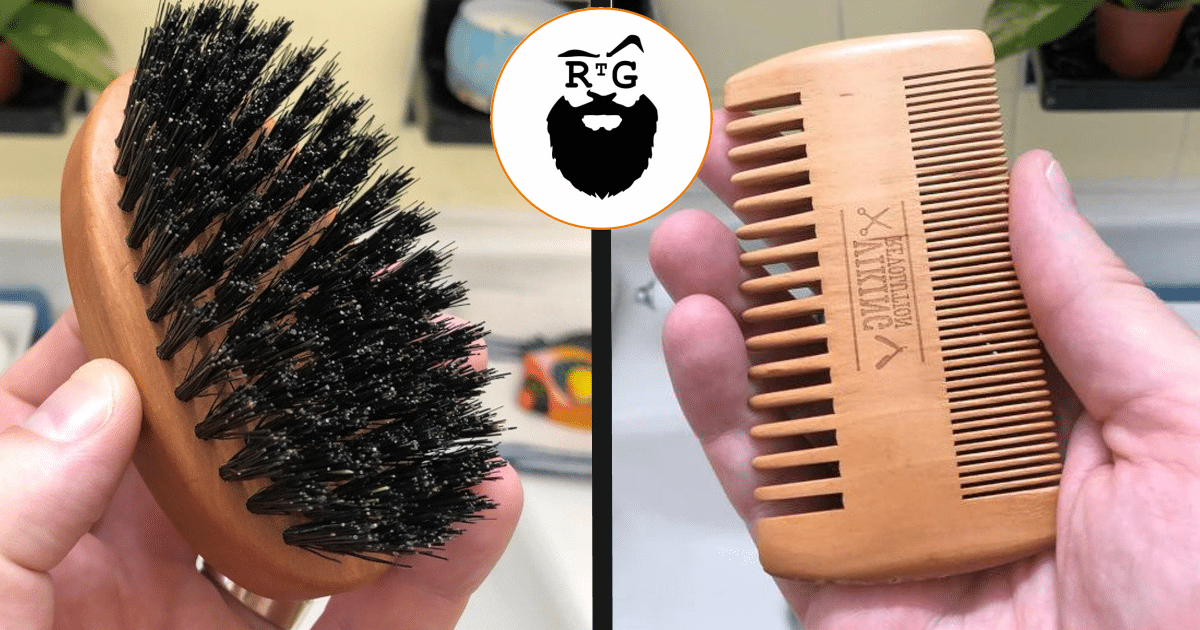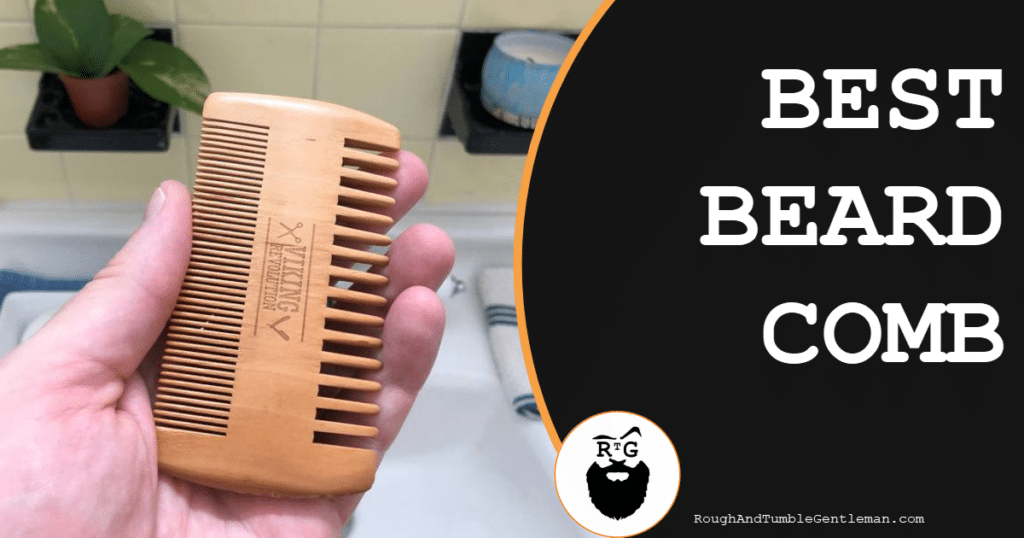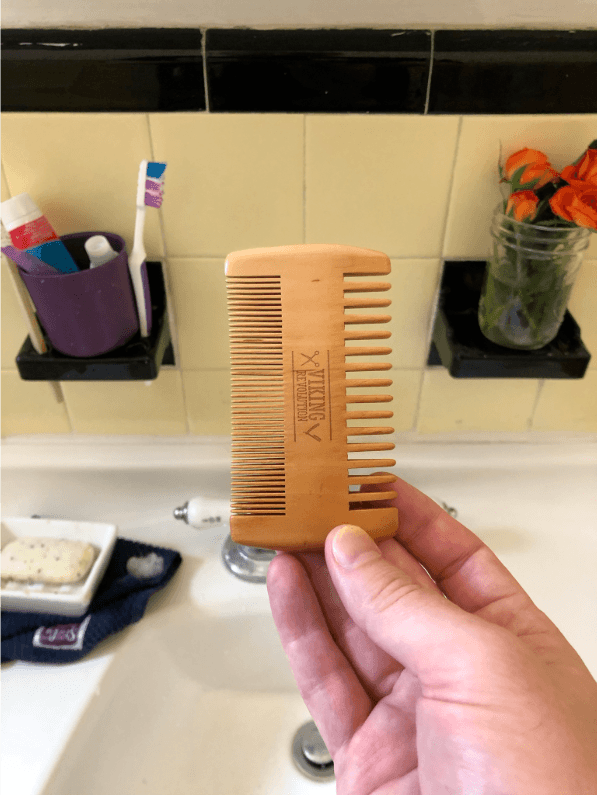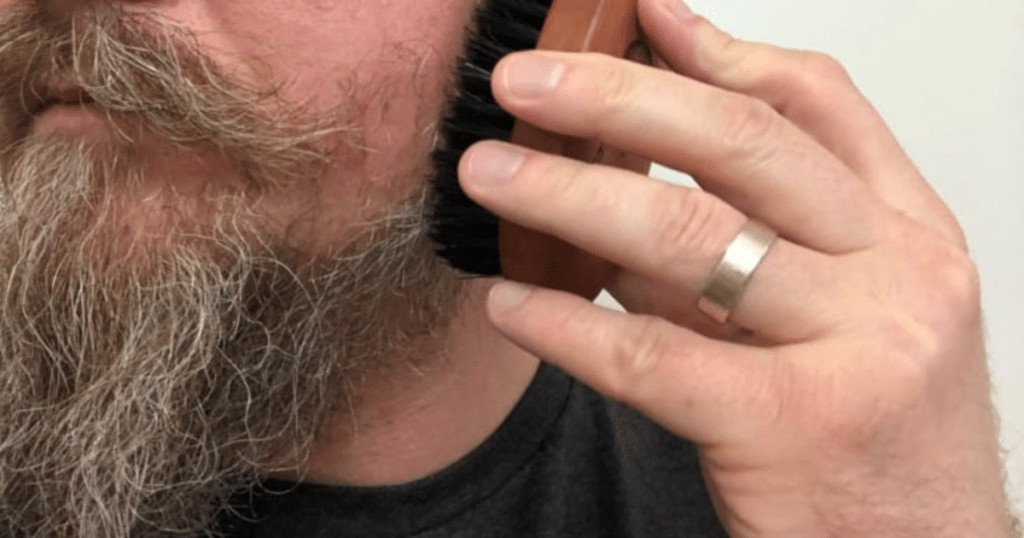If you’re reading this, you’re probably wondering about the difference between a beard brush and a beard comb. That’s not surprising, really—most guys don’t know the difference between those two items. What’s funny is that most guys don’t even know the difference between a regular, for-your-head brush and comb, never mind a beard brush and beard comb. So here, we’ll compare the beard brush vs comb, describe the differences between these grooming tools, and tell you which tool you should use when.
We’ll also share the benefits (and drawbacks) of both beard combs and brushes, and we’ll explain which ones we recommend using for different types of facial hair.
And real-talk—before we had beards, we didn’t know the difference either! So no judgment, we all started somewhere, and we’re glad you’re here.
In a rush? Here’s a quick summary:
Difference Between a Beard Brush and Beard Comb
- A beard comb has long, wider-set teeth, and it’s used for de-tangling a beard.
- A beard brush has dense bristles, and it’s used to shape a beard, to remove dirt and debris and dandruff from a beard, and distribute beard oil and beard balm through a beard.
And some more nuanced differences in how beard combs and beard brushes differ in their use as grooming tools:
- You use a beard comb first, to get tangles and knots out of your beard, and then you follow it up with a beard brush.
- Guys with shorter beards can usually just use a beard comb, but guys with medium- to longer-length beards usually need to start out with a beard comb and follow it up with a brush.
- You’d think that beard combs and brushes are mostly about grooming and shaping a beard (and that’s a big part of it), but they have a few other purposes, too—they help distribute
beard oil and beard balm throughout your beard, keep you from getting split ends, and even keep your beard healthy by invigorating the skin underneath your beard.
That’s the jist of it, but there are a lot of details involved, so let’s start with some images of the two tools and go from there:
Here’s What a Beard Comb Looks Like
Here’s one of our favorite beard combs—it’s the Viking Revolution Dual-Sided Comb:

As we said in our review, it’s a solid beard comb, and it’s designed to untangle beard hair and give a beard some structure, and… that’s it, really! A beard comb’s main job is to untangle beard hair and make it a little neater than it was. It also does a good job of distribution moisturizers like
As you can see, it’s made of wood, and it’s got one side of course, loosely-spaced teeth:
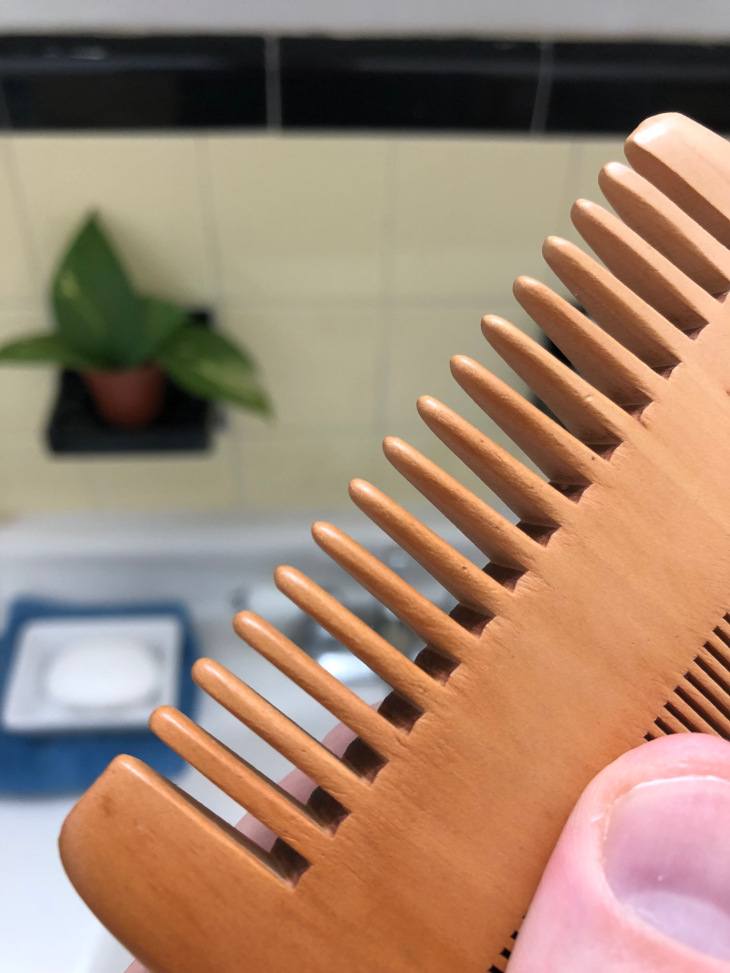
and another row of thin, tightly-spaced teeth:

Not all beard combs are like that—most only have one set of teeth—and that’s why we’re sweet on this one: because it’s like having two combs in one.
The space between the teeth is actually a very important feature of a beard comb, because different teeth work on different types of beards.
Here’s how it plays out:
Fine-Tooth. Fine-toothed combs are great for mustaches or shorter beards. The shorter and thinner the facial hair, the narrower the teeth. If you’re new to having a beard, or if your beard hair is a little wispier, a fine-tooth comb should be fine.
Wide-Tooth. These are great for medium- to long-length beards. At these lengths, your beard is getting thicker and courser, and it can be difficult to drag a fine-tooth comb through a wrangly beard. The looser side of the comb above is a wide-tooth comb; and finally
Extra Wide-Tooth. These are somewhat rare, because not too many guys need them—they’re used for guys with reaaaaaally bushy beards that get tangled really badly. Luckily, most guys don’t need extra wide-tooth combs—these are usually for members of biker gangs, thru-hikers that spent most of their time on the trail, and so on.
You’ll notice, too, that it’s made out of wood. Wood does a *fantastic* job wrangling a beard into place and distributing
Plastic. This is perhaps the most common material for beard combs, and it’s usually the cheapest. Plastic is OK, but it’s not great—plastic can introduce some frizziness to your beard, and because the teeth in a plastic comb often snag at your beard and pull on your skin, beard sites (like this one!) usually advise against them.
In fact, there are a lot of guys who absolutely hate using plastic combs, but hey—to each his own. Plastic combs last forever, and a lot of guys like that.
Rubber. With all the hate that plastic combs get, you’d expect rubber to also be derided, but it’s actually a step up from plastic. Plastic combs are often vulcanized, which can lead to less frizziness/static electricity, and they do a decent job distributing
Metal. Better than rubber, still not as good as wood. While metal won’t make your beard frizzy and it’s also easy to clean, it can be uncomfortable to use, because metal teeth can be unyielding and pull/poke at your skin. They’re also not great for distributing product throughout your beard—metal isn’t really porous, and while it can move balm/oil/etc. around, it never seems to really get all throughout a beard.
(And, again—if you like using metal combs, more power to you! Whatever works. That said, it’s widely agreed that if you want a top-tier beard comb, you’ll select…)
Wood. A beard comb made out of wood usually does everything right: it’s gentle, so you can drag through your beard without too much agony; it doesn’t introduce any frizz to your beard, and in fact inhibits split ends; and finally it’s porous, so that wood can transport
The only exception is animal horn—there are some beard combs made from animal horn (usually ox), and those work exceptionally well too.
Alright! So that’s beard combs (and if you’re curious, here’s a list of the beard combs we like the most).
Next up in our “beard brush vs. comb” discussion is…
Here’s What a Beard Brush Looks Like
Beard brushes are usually round or rectangular, like this one:
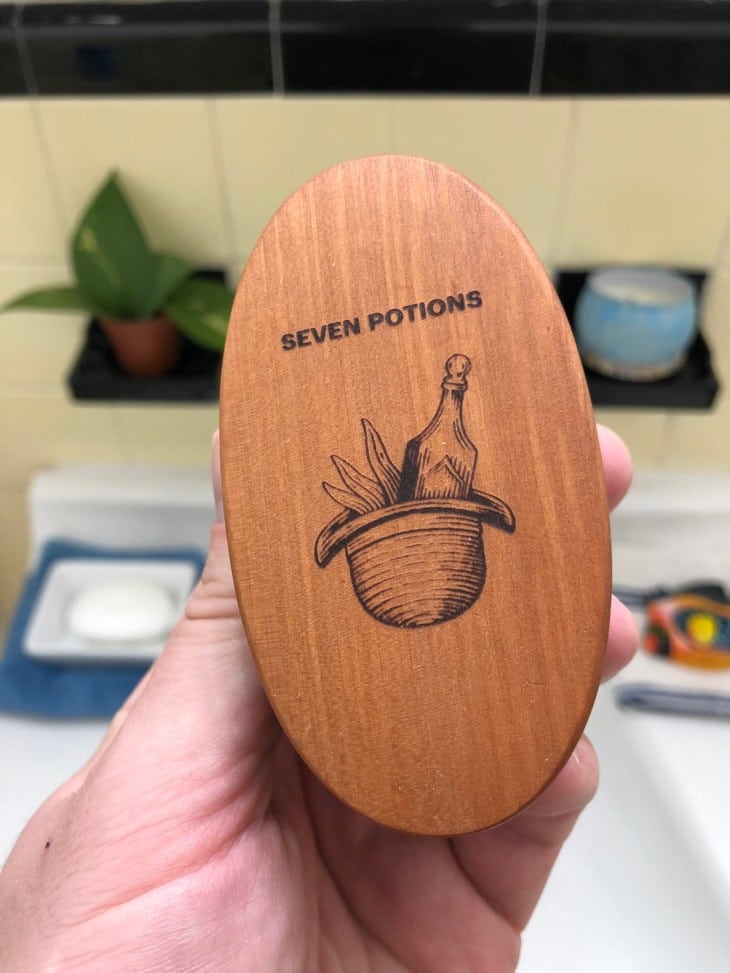
That’s the Seven Potions Beard Brush (affiliate link), which we like a lot. As you can see, it’s got rows of densely-packed, short bristles:
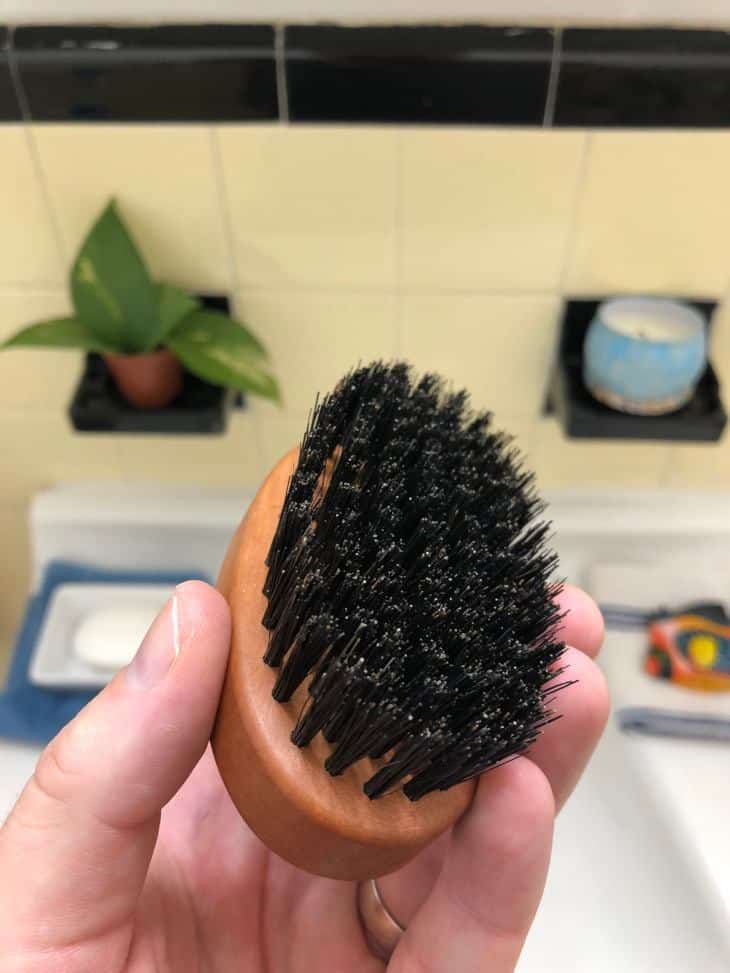
It’s a pretty basic brush—some of them get pretty fancy—but it’s great if you’re just starting out.
Just like a beard comb, the base of the brush—the part you hold—can be made of different materials. Plastic, rubber, metal, and wood are all options, which wood being the most effective.
Some have handles that you can grasp, but most don’t. Neither is better, really, but most guys seem to opt for the non-handled versions.
As you may have guessed, the most important feature on a beard brush are those bristles. Let’s take a closer look:
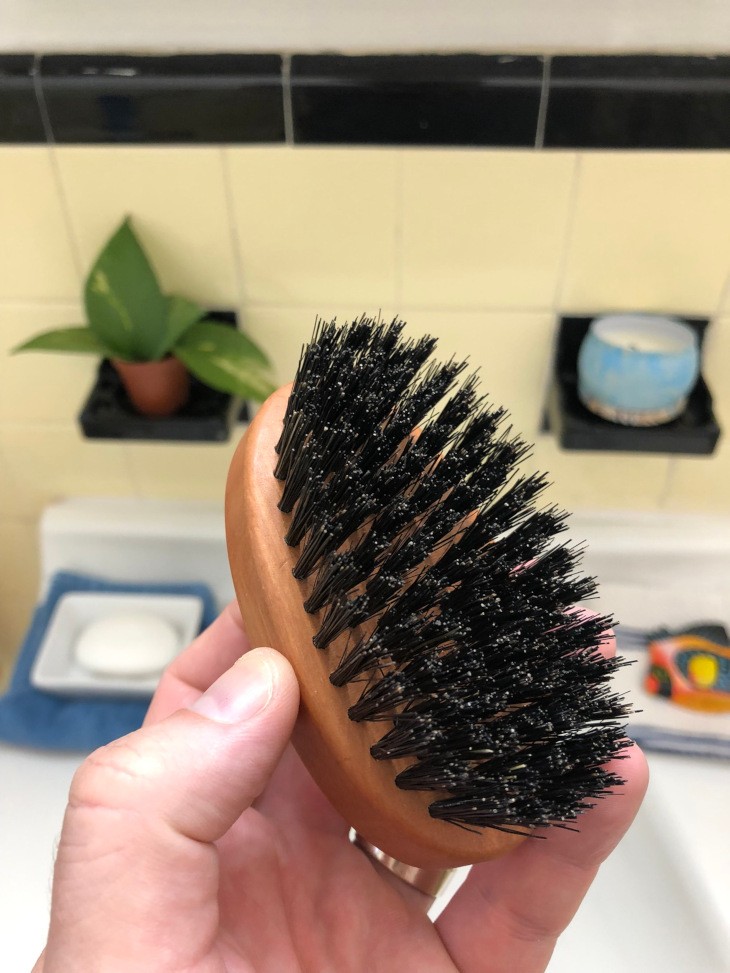
Those bristles do a LOT of things all at once:
Brushes Pull a Beard into Place. Because they’re so tightly packed together, those bristles can reaaaaaaally pull your beard into shape, and it takes a little effort to do so.
That’s why you need to use a beard comb first—dragging a beard brush through a tangled beard, with all those tightly-packed bristles catching on every knot and snag, is basically torture. You’re going to tug on your beard and whiskers, and something’s gotta give—and that something is usually your skin or hair! After a quick comb, though, a beard brush can glide through even a thick beard and give it some shape.
Brushes Distribute Products Throughout Your Beard. Even moreso than a beard comb, a beard brush can bring
Brushes Distribute Sebum Throughout Your Beard. This is the first time we’re mentioning “sebum” in this post, so here it is: sebum is a natural oil that your skin forms, and it 1) makes your skin pliant and supple, and 2) hydrates the hair on your face. When your beard gets very long, that sebum doesn’t come into contact with your whiskers—and how could it? The oil on your face can’t travel the length of your beard without some help, and a good beard brush can make that happen. That’s one aspect of beard brushes that often gets overlooked—that it can transport the oils from your skin to your beard—and it’s important. There’s one other overlooked thing a beard brush can do, and that’s…
Brushes Increase the Blood Flow in Your Face. Whaaaaa? This one sounds bonkers but it’s true. Think about it: when you pull a beard brush through your beard, it tugs gently on your beard hairs, which tugs gently on the base of your whiskers at the skin. That tug gets blood circulating in your skin, which brings hydration and sebum and nutrients to the base of the beard hair. That stimulates the follicles and strengthens them, and can even help them grow more robustly. Crazy, right? Who knew.
Brushes Fight Split Ends. Have you ever seen a big beautiful bushy beard get ruined by split ends? It’s such a shame, but it happens a lot—particularly when guys don’t tend to their facial hair. Brushes straighten and shape beard hairs, decreasing the chances they’ll get split, and when you use a beard product (such as oil or balm or butter), you further decrease the chances of split-ends by fortifying each of the beard hairs that get coated in the product. That’s a big deal, because even guys who can grow a big beard see them diminished by split ends. Finally…
Brushes Can Remove Beardruff from Your Beard. This is a big one. Beardruff is a big problem for a LOT of guys, particularly when they’re in the stage when a short beard becomes a medium-length beard. Beard brushes can do a bang-up job ridding a beard of beardruff, whereas a beard comb can’t—a beard comb isn’t really dense enough to drag any of that beardruff out of a beard, but a beard brush, with all those tightly-packet bristles, can get the job done. Nice.
As for the bristles themselves, they come in a few different varieties, with the most popular being:
Boar’s Hair. Yes, boar. Boar’s hair is still yet pliable, dense yet porous, and perfect for beard brushes. Weird, right? Well, that’s how it goes. Beard brushes made from boar’s hair are usually seen as top-notch, but there are some beard brushes made from horse’s hair that are also good (but the general consensus is that boar’s hair is best).
Synthetic Bristles. There are many among us who don’t want to harm animals in any way, and those good brothers usually opt for a synthetic-bristle brush. The bristles in a synthetic brush act just as the bristles in a typical beard brush would, and straighten beard hair and move beard products throughout the beard.
Alright! Now you know. Before we move on, though…
One More Note About Length
We mentioned above that brushes are good for short beards, and that combs—and then brushes—are good for medium-length to longer beards. We get a lot of questions about what constitutes a short, medium, and long beard, so here goes:
A shorter-length beard is usually a month or two old, and maybe an inch long. During this time, a beard brush should do you fine, and your whiskers aren’t really long enough to need a beard brush.
A medium-length beard is usually two to four months old, and longer than an inch. At this stage, your beard is just about thick enough to need some detangling with a beard comb, and thick enough to need some well-dispersed moisturizing with a beard brush and some product.
A longer-length beard is usually four or more months old, and two inches or longer in length. At this stage—if you’re physically capable of growing a beard—you will most certainly need a beard comb for detangling following by a beard brush with some products.
Those are generalities, of course—every guy grows beard and hair at different rates and thicknesses—but those measurements seem to be true for the majority of guys.
OK! So now you know the what, when, where, and how. Now let’s talk details and get to some questions you probably have:
FAQs and Usage Tips to Keep in Mind
We get a lot of questions from our “Contact” page, and here are some of the most common:
Do I Need to Comb/Brush My Hair? Is This Necessary?
Nope! Not really. Not all the time, anyway—there are plenty of guys who have decent beards that wash them in the shower, trim them when necessary, and look fine. Most of those guys have shorter beards, and they’re perfectly happy with themselves and their beards.
There are a few occasions, though, where it can become important, and it can be a very good idea to comb and brush your beard, if…
You Have a Medium- to Long-Length Beard. Guys with shorter beards can get away with not combing/brushing, but once your beard gets to be an inch or longer, it’s very common for a beard to look like a tangled mess. That’s not your fault—it’s just how it is. Unchecked facial hair just looks sloppy, and one of the best ways to tame is to give it some TLC. You may find that’s not the case for you—that you can get to two or three inches without looking crazy—and that’s awesome. But for a lot of guys, combing/brushing a medium- to long-length beard is the only way to keep it from looking like a disaster.
Your Beard Needs Some Guidance. We didn’t really touch on this above, but a lot of guys want to train their beards. As we just mentioned, even aside from “general disarray,” some beards do some crazy things—it can grow in weird directions, it can swirl and sworl, it can kink up a certain length for no reason at all. A lot of guys have luck getting their beards to grow in a certain way, and the only way to do that is guide it on the daily. Avoiding those pitfalls can be a labor-intensive thing, but it’s definitely do-able, and once- or twice-daily combing/brushing (along with products) is usually the most effective way. Speaking of products…
You Want to Use Any Kind of Beard Product. Beard products are—and this pains us to say it—notoriously hard to use. It’s really difficult to get a
When Should I Use a Beard Comb / Brush?
OK, so we’ve convinced you a comb/brush combo are important. So when do you use it?
You can use them at any time, really, as long as you start with the comb first and then move on to the brush.
The best time, however, is usually right out of the shower. When your beard hair is wet, a beard comb can detangle your beard from its shower knots, and once it’s a little bit dryer, and after you’ve applied any beard products you’re going to use, you can follow it up with a beard comb.
A Beard Wash in the Shower Can Be a Huge Help
One of the best things you can do to untangle your beard—and one of the things that guys who forego combing/brushing do—is to use a beard wash in the shower.
There are a ton we like, but Grave Before Shave Beard Wash (affiliate link) is one of our favorites, as is Every Man Jack Beard Wash (affiliate link).
If You’re Getting Beardruff After You Start Combing/Brushing…
You’ve got two options:
1) Try a Beard Butter. Beard butters aren’t so well-known among guys who have beards, but among the guys who *do* know about them, they have a lot of fans. Basically, they’re like beard balms, but instead of wax, they contain cocoa butter or shea butter, which does a great job moisturizing the skin—and that can fix the problem that causes beardruff, which is dry, flaky skin. Our favorite beard butter is Bluebeard’s Original Beard Saver (affiliate link). It doesn’t have the notoriety of a lot of other beard companies, but we’ve found it does a really great job at relieving beard itch, tamping down beardruff, and alleviating irritation.
2) You Can Lay Off for a While. Beard combs and beard brushes work great for a lot of guys, but sometimes they can irritate the skin. If you find that happening to you, wait off a bit and see if the problem persists. Sometimes it’ll go away. You may also want to give your beard a trim—sometimes guys experience beardruff once their beard hits a certain length, and the only cure is trimming it a bit. That’s lousy, but not everybody is meant to have a long beard, sadly.
Do I Need to Clean a Brush and/or Comb?
Why yes, yes you do. Cleaning a beard comb is pretty easy—just take the comb and give it a good scrub in the shower. Anything that cuts grease and/or oil should do the trick—a hand soap, facial soap, or even a shampoo can strip a beard comb of product and oil. Keep in mind, with a wooden comb, you’ll never get all of that product and/or oil off, but that’s part of the charm of using a wooden comb.
Beard brushes are a little trickier. Basically, you want to remove and hair and skin from the brush, remove any loose bristles, and then set it in a bowl contain hot water and a little of shampoo. Slosh it around gently and run your fingers over and through the bristles to release some of the built-up product and oil. After about a minute of that, run it under warm water to get all the shampoo out, and then run your fingers over the bristles so that they spray out any remaining water/moisture. Let it dry, and then you’re good to use it again.
Do I Need to Replace a Comb or Brush?
Here’s how it plays out:
You Can Use a Well-Build Beard Comb for a Long Time. Combs tend to last for a while, and with proper care, you can use them for years. The only time you’d need to get rid of one is if you never cleaned it properly, and it started to smell funky. That can absolutely happen, so be sure to take of it—not only is it bad for the comb to have all that funk on it, but it can be bad for your skin, too—if you run rub all that funky product and old oil on your skin, you can get rashes, irritation, etc. Gross, and unpleasant. So clean the comb, even if you think it doesn’t need it.
You Should Replace a Beard Brush Every Few Months. This is a little bit gross, but beard brushes can get pretty intimate—they really get in your beard, and they can pull out hair and skin bits and bacteria, and so you 1) need to clean them very well, very frequently, and 2) need to replace them after a few months. They, too, can smell pretty funky after extended use, and you don’t want to drag all the funky stuff through your hair and across your skin. They also simply fall apart after a while—because they mostly bristle, they fall into disrepair eventually, and need to be replaced.
Brushes and Combs We Like
This is actually a good opportunity to talk about some beard combs and beard brushes we like! Here are our favorites—we’ll keep this brief:
Beard Combs We Like:
- The Viking Revolution Dual-Sided Comb (affiliate link). Two rows of teeth! Tapered edges! A nifty little leather carrying case! In other words, everything we look for in a beard comb. It’s got a great color to it (although we understand that because it’s wood, each comb is unique), and ours is a nice warm orange-y hue.
- The Striking Viking Folding Wooden Comb (affiliate link). When you review products, you eventually come to peace with the idea that most of them are named “Viking.” We consider this a runner-up to the Viking Revolution model because it only has a single set of teeth, but it’s still very good—and in fact, great for thick beards that are shorter.
Beard Brushes We Like:
- Seven Potions Beard Brush for Men (affiliate link): Remember above, how we said that the best beard brushes come with boar hair? This one does, and it’s got a nice shape and feel to it. It’s densely-bristled but not *too* densely-bristled. Great for getting beard products into your beard.
- Beard Brush by ZilberHaar (affiliate link): The ZilberHaar meets that golden standard to bristle—that of boar—but its standout feature is its handle. Some guys hate palming the regular oval brushes, and do better with a handled beard brush. If that’s you, here you go!
- Tombstone Beard Brush (affiliate link): We mentioned above that there some good-hearted brothers among us who don’t want to use a boar’s hair beard brush, and for them, we usually recommend the Tombstone Beard Brush. Get shape, sturdy bristles, nice to hold.
Kits We Like!
We’d be remiss if we didn’t mention any packaged products. There are plenty in the beard world, and here are our favorites.
If you’re looking for a comb-and-brush combo, we like:
- Viking Revolution Beard Comb & Beard Brush Set for Men (affiliate link): This is actually the beard comb we pictured above, along with a beard brush (with boar’s hair) and a small scissor for detail work on the mustache and beneath-the-chin beard. This is a great little case if you’ve got a short beard, or if you’re looking for a travel pack.
- The Beard Brush, Beard Comb, Beard Oil, & Beard Balm Grooming Kit for Men’s Care (affiliate link): Wouldn’t it be nice if you could get a comb, a brush, and two of the most popular beard grooming items—beard oil and beard balm—all at once? Well, here you are. The bristles on the brush are boar and the wood itself is bamboo, which is known for sturdiness and longevity. Nice.
Wrapping Up the Beard Brush vs Comb Debate
There you have it! All you could ever hope to know about beard brushes and beard combs. We hope we’ve answered all your questions, but if there’s anything else you want to know, jump over to our “Contact” page and drop us a line. In the meantime—be good, have fun, and happy beard!
Michael Morris is the head writer here at Rough and Tumble Gentleman. He's got a ducktail beard and loves Brazilian jiu-jitsu. He's married to the woman of his dreams and lives in Brooklyn, NY.

